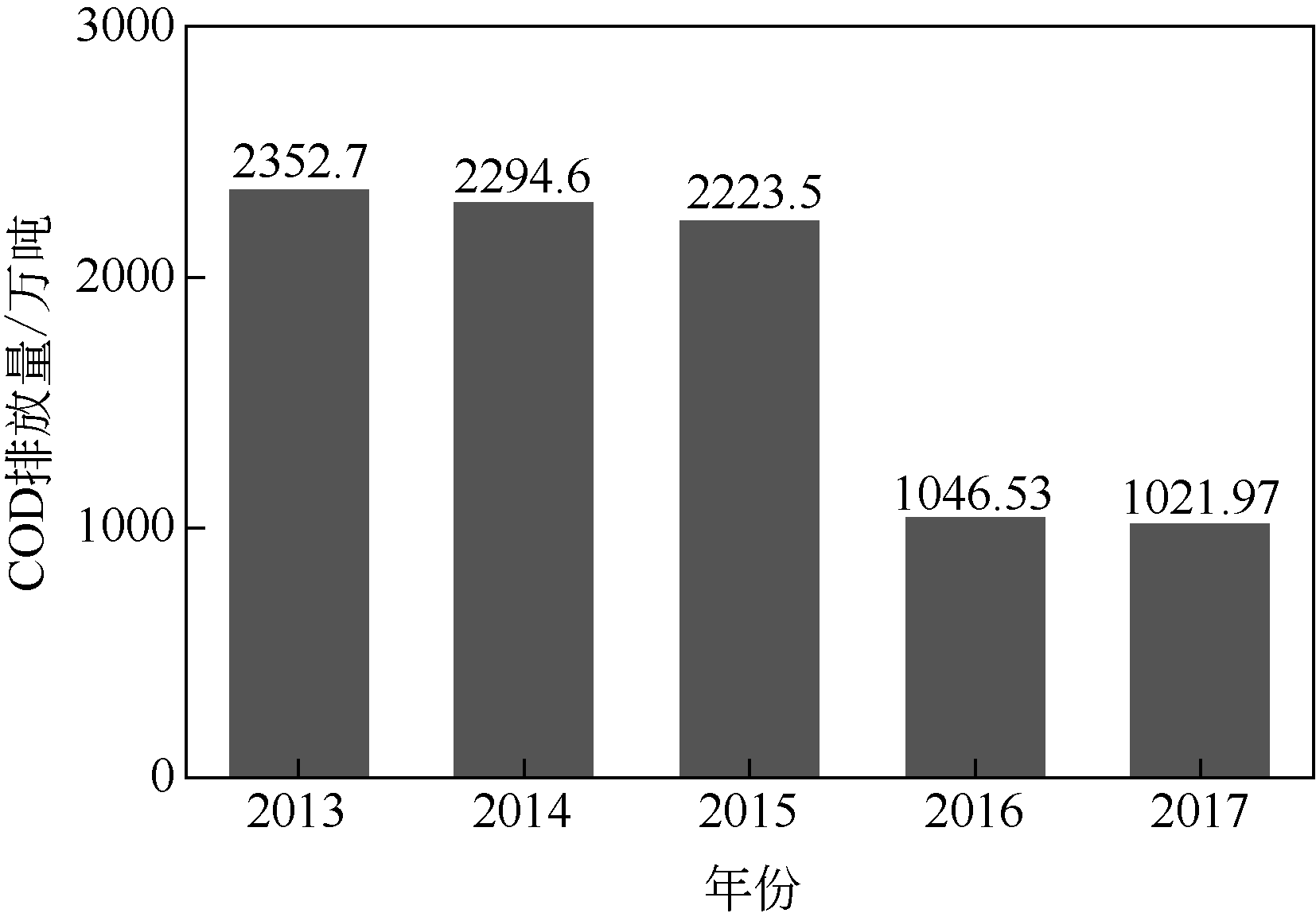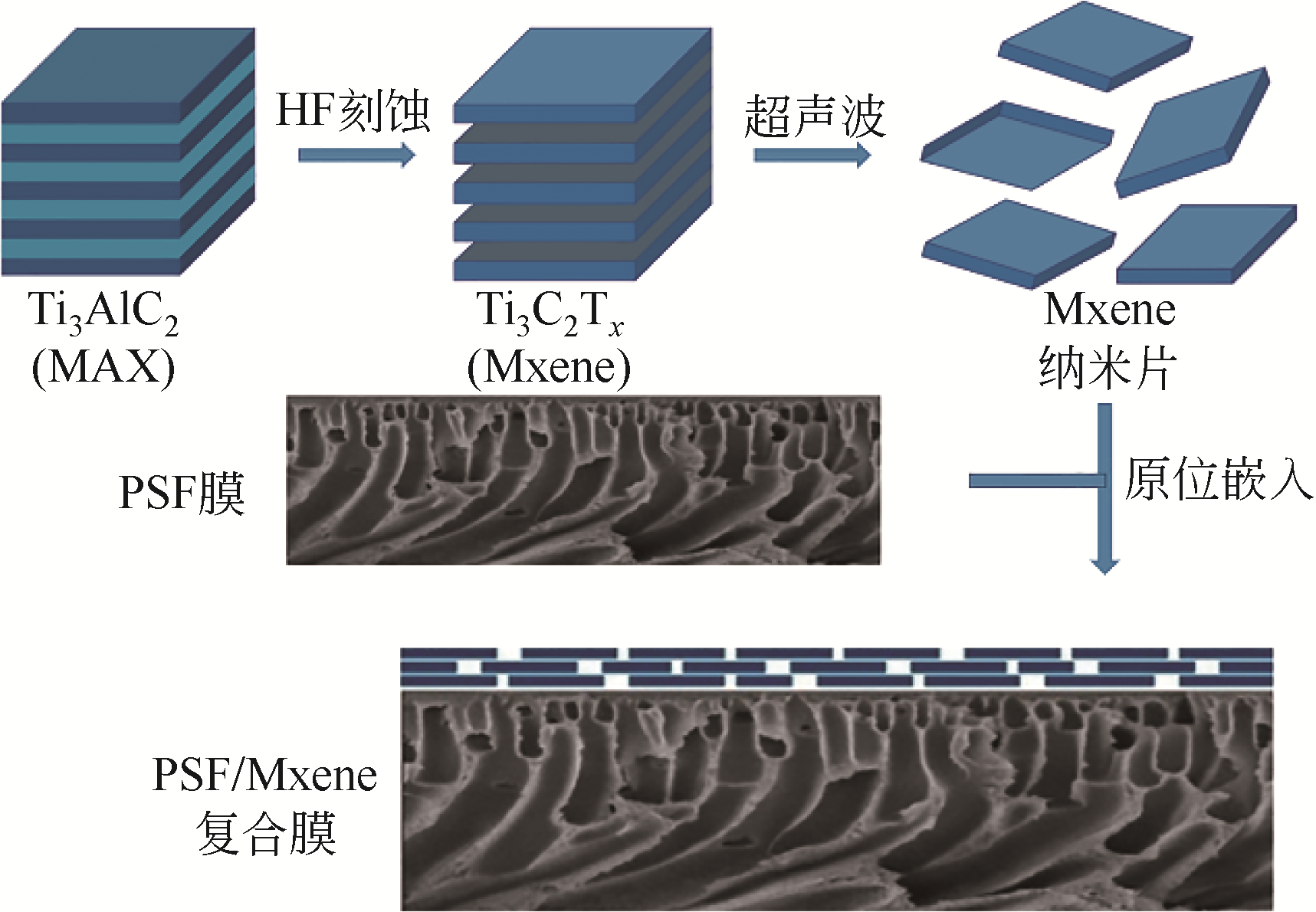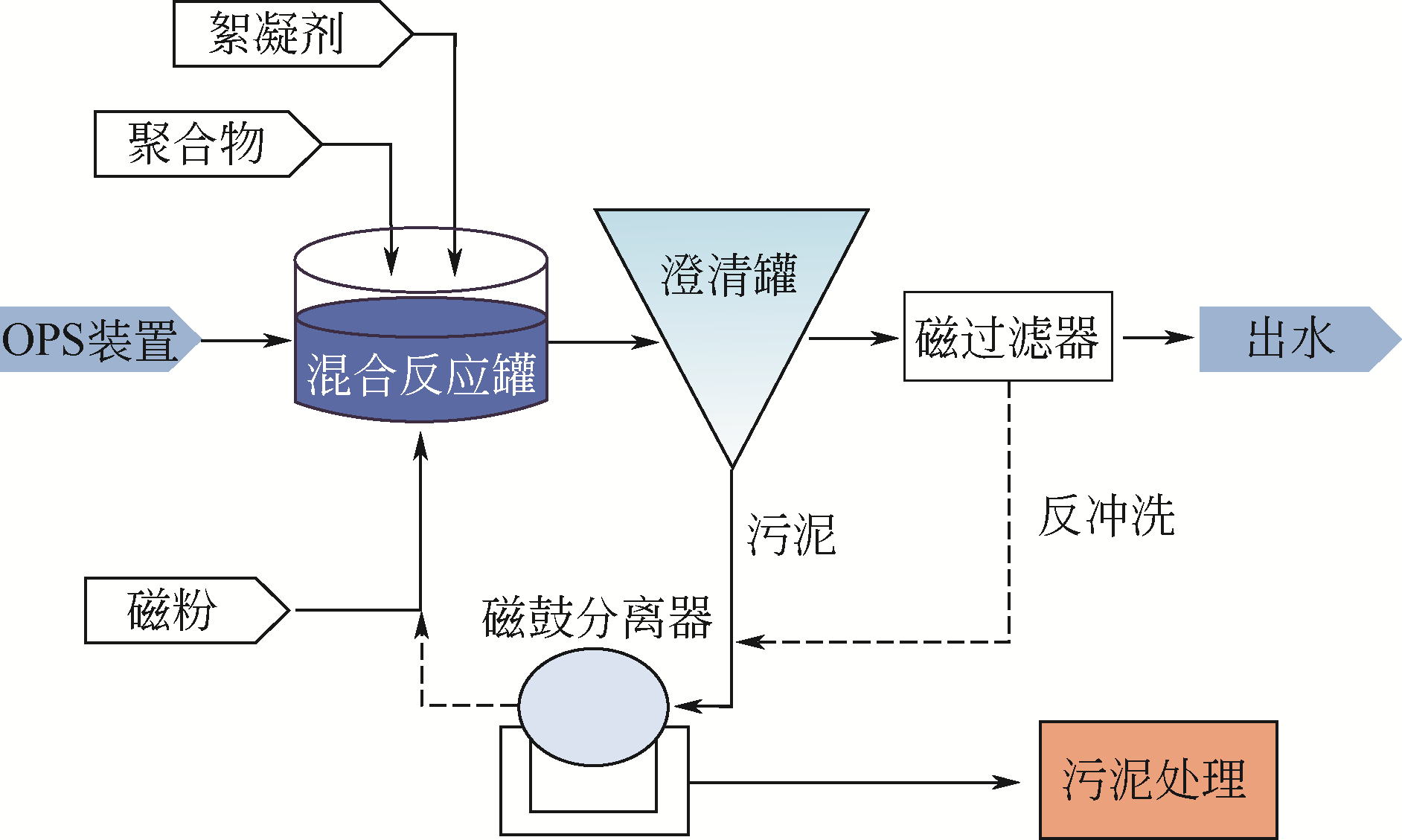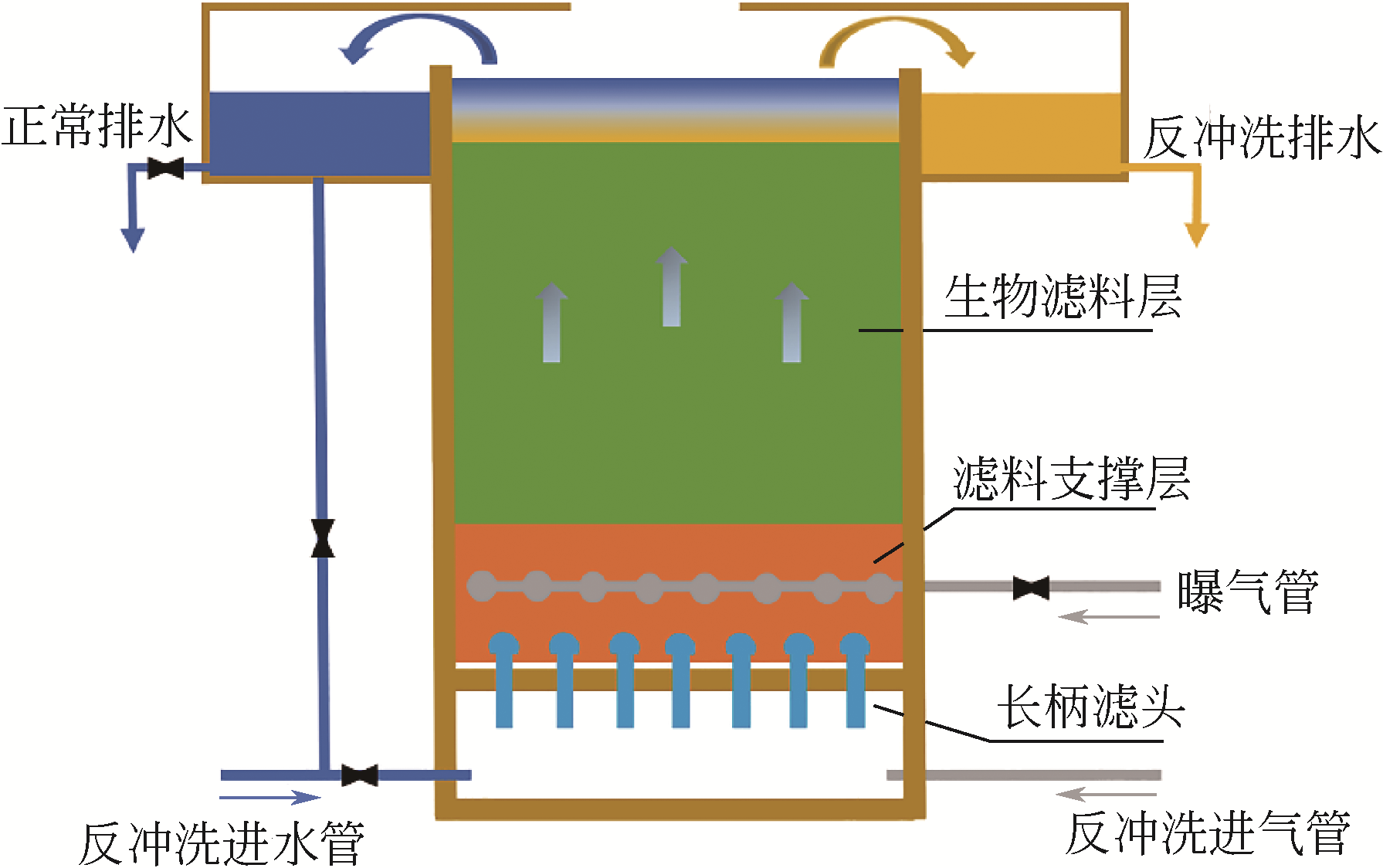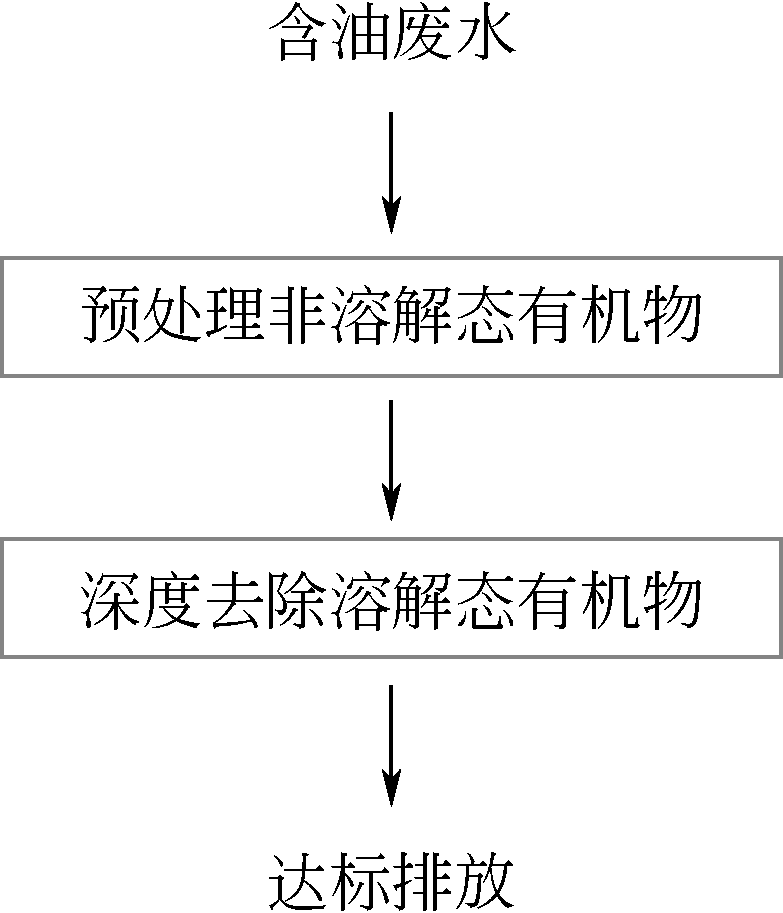化工进展 ›› 2021, Vol. 40 ›› Issue (1): 451-462.DOI: 10.16085/j.issn.1000-6613.2020-0452
含油废水处理工艺研究进展及展望
王长青1,2( ), 张西华1(
), 张西华1( ), 宁朋歌2(
), 宁朋歌2( ), 苑文仪1, 白建峰1, 王景伟1
), 苑文仪1, 白建峰1, 王景伟1
- 1.上海第二工业大学电子废弃物研究中心,资源循环科学与工程中心,上海电子废弃物资源化协同创新中心,上海 201209
2.中国科学院过程工程研究所环境技术与工程研究部,绿色过程与工程重点实验室,北京市过程;污染控制工程技术研究中心,北京 100190
-
收稿日期:2020-03-24出版日期:2021-01-05发布日期:2021-01-12 -
通讯作者:张西华,宁朋歌 -
作者简介:王长青(1995—),男,硕士研究生,研究方向为萃取分离技术。E-mail:527224943@qq.com 。 -
基金资助:上海第二工业大学研究生项目基金(EGD19YJ0016);中科院STS资助项目(KFJ-STS-QYZD-081);上海市高原学科-环境科学与工程(资源循环科学与工程)资助项目;上海高校知识服务平台项目(ZF1224)
Research advances and perspective on treatment processes for oily wastewater
Changqing WANG1,2( ), Xihua ZHANG1(
), Xihua ZHANG1( ), Pengge NING2(
), Pengge NING2( ), Wenyi YUAN1, Jianfeng BAI1, Jingwei WANG1
), Wenyi YUAN1, Jianfeng BAI1, Jingwei WANG1
- 1.WEEE Research Center, Research Center of Resource Recycling Science and Engineering, Shanghai Polytechnic University, Shanghai Collaborative Innovation Center for WEEE Recycling, Shanghai 201209, China
2.Beijing Engineering Research Center of Process Pollution Control, Key Laboratory of Green Process and Engineering, Division of Environment Technology and Engineering, Institute of Process Engineering, Chinese Academy of Sciences, Beijing 100190, China
-
Received:2020-03-24Online:2021-01-05Published:2021-01-12 -
Contact:Xihua ZHANG,Pengge NING
摘要:
许多工业过程中产生含油废水,如石油提炼、石化、食品、皮革和金属加工等,一直是工业污染防控的重点和难点。随着工业生产技术的不断发展,含油废水中特征污染物种类和排放量亦持续增加,对工业废水中油分的深度处理及回收提出了挑战。由于含油废水中有机物种类繁多、环境各异、内部反应复杂,不仅影响多级工艺的生产效率,而且存在一定的环境风险。因此,工业含油废水的高效深度处理及回收是工业污染防控的必然要求,对工业生产的可持续发展具有重要的推动作用。鉴于此,本文在系统解析工业含油废水特点的基础上,分别从单独工艺和组合工艺的视角综述了近年来国内外处理乳化油和溶解油的最新研究进展,重点分析了基于树脂吸附除油技术的原理特性、除油潜力、应用效益及其相较于其他除油技术的优势,最后对树脂除油技术的发展前景进行展望。
中图分类号:
引用本文
王长青, 张西华, 宁朋歌, 苑文仪, 白建峰, 王景伟. 含油废水处理工艺研究进展及展望[J]. 化工进展, 2021, 40(1): 451-462.
Changqing WANG, Xihua ZHANG, Pengge NING, Wenyi YUAN, Jianfeng BAI, Jingwei WANG. Research advances and perspective on treatment processes for oily wastewater[J]. Chemical Industry and Engineering Progress, 2021, 40(1): 451-462.
| 工艺类型 | 主要单元 | 废水主要来源 | 主要污染物 |
|---|---|---|---|
| 蒸馏 | 常压、蒸馏真空、蒸馏 | 脱盐废水、蒸馏塔顶油水、分离排水、机泵冷却水 | 石油、硫化物、氨、挥发性酚、氯化物、硫醇、悬浮物 |
| 裂化 | 催化裂化、加氢裂化 | 分馏塔顶油水、分离排水、富气洗水、汽油洗水、液态碳氢化合物截水、回流罐截水 | 石油、硫化物、挥发性苯酚、氰化物、氨气、硫醇 |
| 催化 | 烷基异构化 | 回流罐截水、设备总排水 | 废碱液、石油、硫化物、硫醇、氨、挥发性酚 |
| 精制 | 加氢精制 | 分馏塔顶回流罐切削水、低压分离排水、汽油洗水、机泵冷却水 | 氨、硫化物、挥发性酚、石油 |
表1 炼油厂的主要废水来源[4]
| 工艺类型 | 主要单元 | 废水主要来源 | 主要污染物 |
|---|---|---|---|
| 蒸馏 | 常压、蒸馏真空、蒸馏 | 脱盐废水、蒸馏塔顶油水、分离排水、机泵冷却水 | 石油、硫化物、氨、挥发性酚、氯化物、硫醇、悬浮物 |
| 裂化 | 催化裂化、加氢裂化 | 分馏塔顶油水、分离排水、富气洗水、汽油洗水、液态碳氢化合物截水、回流罐截水 | 石油、硫化物、挥发性苯酚、氰化物、氨气、硫醇 |
| 催化 | 烷基异构化 | 回流罐截水、设备总排水 | 废碱液、石油、硫化物、硫醇、氨、挥发性酚 |
| 精制 | 加氢精制 | 分馏塔顶回流罐切削水、低压分离排水、汽油洗水、机泵冷却水 | 氨、硫化物、挥发性酚、石油 |
| 乳剂 | 破乳率/% | ||||||
|---|---|---|---|---|---|---|---|
| 球形角球菌 | 溶脂曲霉(a) | 溶脂曲霉(b) | 吉利蒙德氏菌 | 洋葱头孢 | 芽孢杆菌 | 铜绿假单胞菌 | |
| W/O | 90.0±0.9 | 38.2±0.9 | 44.0±0.9 | 30.0±0.9 | 30.0±0.9 | 37.0±0.9 | 35.0±0.9 |
| O/W | 94.7±0.4 | 35.7±0.4 | 45.2±0.9 | 32.0±0.9 | 33.4±0.8 | 41.0±0.9 | 38.2±0.5 |
表2 生物表面活性剂对W/O和O/W模型乳状液的破乳性能[39]
| 乳剂 | 破乳率/% | ||||||
|---|---|---|---|---|---|---|---|
| 球形角球菌 | 溶脂曲霉(a) | 溶脂曲霉(b) | 吉利蒙德氏菌 | 洋葱头孢 | 芽孢杆菌 | 铜绿假单胞菌 | |
| W/O | 90.0±0.9 | 38.2±0.9 | 44.0±0.9 | 30.0±0.9 | 30.0±0.9 | 37.0±0.9 | 35.0±0.9 |
| O/W | 94.7±0.4 | 35.7±0.4 | 45.2±0.9 | 32.0±0.9 | 33.4±0.8 | 41.0±0.9 | 38.2±0.5 |
| 工艺 | 降解产品清单 |
|---|---|
| 焦化废水 | 苯酚;苯胺;2-甲基苯酚;3-甲基苯酚;2,4-二甲基苯酚;3,5-二甲基苯酚;3,4-二甲基苯酚;2,3-二氢苯和呋喃;喹啉;蒽;1(2H)-异喹啉 |
| 混凝 | 苯酚;苯胺;2-甲基苯酚;3-甲基苯酚;2,4-二甲基苯酚;3,5-二甲基苯酚;3,4-二甲基苯酚;2,3-二氢苯呋喃;喹啉;蒽;1(2H)-异喹啉 |
| 混凝+O3催化氧化 | 苯酚;5-甲基糠醛;2-甲基苯基肼;4,5-二甲基-2-羟基嘧啶;乙酸松香;2,3,4,5-四甲基-2-环戊烯酮;2-甲基苯酚;4,5,6-三甲基-2-嘧啶酮;苯并呋喃;喹啉;4-溴-3-甲基苯酚;2,3-二氢吲哚-4-醇-2-酮;N-苯基甲酰胺 |
表3 不同工艺组合处理焦化废水的降解产物清单[55]
| 工艺 | 降解产品清单 |
|---|---|
| 焦化废水 | 苯酚;苯胺;2-甲基苯酚;3-甲基苯酚;2,4-二甲基苯酚;3,5-二甲基苯酚;3,4-二甲基苯酚;2,3-二氢苯和呋喃;喹啉;蒽;1(2H)-异喹啉 |
| 混凝 | 苯酚;苯胺;2-甲基苯酚;3-甲基苯酚;2,4-二甲基苯酚;3,5-二甲基苯酚;3,4-二甲基苯酚;2,3-二氢苯呋喃;喹啉;蒽;1(2H)-异喹啉 |
| 混凝+O3催化氧化 | 苯酚;5-甲基糠醛;2-甲基苯基肼;4,5-二甲基-2-羟基嘧啶;乙酸松香;2,3,4,5-四甲基-2-环戊烯酮;2-甲基苯酚;4,5,6-三甲基-2-嘧啶酮;苯并呋喃;喹啉;4-溴-3-甲基苯酚;2,3-二氢吲哚-4-醇-2-酮;N-苯基甲酰胺 |
| 1 | 解宏端, 刑文东, 杨雨桐, 等. 含油废水处理技术现状及发展趋势[J]. 科技资讯, 2015, 13(18): 137-139. |
| XIE Hongduan, XING Wendong, YANG Yutong, et al. Current status and development trend of oily wastewater treatment technology[J]. Science and Technology Information, 2015, 13(18): 137-139. | |
| 2 | 杨瑞, 张翻. 含油废水处理技术进展[J]. 当代化工, 2018, 47(8): 161-163, 167. |
| YANG Rui, ZHANG Fan. Progress of oily wastewater treatment technology [J]. Contemporary Chemical Industry, 2018, 47(8): 161-163, 167. | |
| 3 | PAL S, BANAT F, ALMANSOORI A, et al. Review of technologies for biotreatment of refinery wastewaters: progress, challenges and future opportunities[J]. Environmental Technology Reviews, 2016, 5(1): 12-38. |
| 4 | 顾莹莹, 李鸿江, 赵由才. 废水是如何变清的: 倾听地球的脉搏[M]. 北京: 冶金工业出版社, 2012: 1-235. |
| GU Yingying, LI Hongjiang, ZHAO Youcai. How the wastewater is clear: listening to the pulse of the earth[M].Beijing: Metallurgical Industry Press, 2012: 1-235. | |
| 5 | YU S, WANG X, YAO W, et al. Macroscopic, spectroscopic, and theoretical investigation for the interaction of phenol and naphthol on reduced graphene oxide[J]. Environmental Science & Technology, 2017, 51(6): 3278-3286. |
| 6 | ZEINSTRA-HELFRICH M, MURK A J. Deep oil spills[M]. Switzerland: Springer International Publishing, 2020: 155-169. |
| 7 | KAJITVICHYANUKUL P, HUNG Y T, WANG L K. Membrane technologies for oil-water separation [M]. New Jersey: Humana Publishing House, 2011: 639-668. |
| 8 | 吴青谚, 向波, 夏仙满, 等. 湿法冶金工艺中的除油技术[J]. 湿法冶金, 2017, 36(4): 251-256. |
| WU Qingyu, XIANG Bo, XIA Xianman, et al. Deoiling technology in hydrometallurgy process [J]. Hydrometallurgy, 2017, 36 (4): 251-256. | |
| 9 | 李忠琳, 陈小刚, 芮斌, 等. 含油乳化废水处理技术研究现状与进展[J]. 化学与生物工程, 2018, 35(5): 14-18. |
| LI Zhonglin, CHEN Xiaogang, RUI Bin, et al. Research status and development of oily emulsified wastewater treatment technology[J]. Chemical and Bioengineering, 2018, 35(5): 14-18. | |
| 10 | JAMALY S, GIWA A, HASAN S W. Recent improvements in oily wastewater treatment: progress, challenges, and future opportunities[J]. Journal of Environmental Sciences, 2015, 37(11): 15-30. |
| 11 | ZHAO J X, WANG W, YE C C, et al. Gravity-driven ultrafast separation of water-in-oil emulsion by hierarchically porous electrospun poly(L-lactide) fabrics[J]. Journal of Membrane Science, 2018, 563: 762-767. |
| 12 | WANG K, HAN D S, YIMING W, et al. A windable and stretchable three-dimensional all-inorganic membrane for efficient oil/water separation[J]. Scientific Reports, 2017, 7(1): 10681. |
| 13 | PADAKI M, MURALI SURYA R, ABDULLAH M S, et al. Membrane technology enhancement in oil-water separation: a review[J]. Desalination, 2015, 357: 197-207. |
| 14 | ZHU Y Z, WANG D, JIANG L, et al. Recent progress in developing advanced membranes for emulsified oil/water separation[J]. NPG Asia Materials, 2014, 6(5): e101. |
| 15 | SHUKLA A K, ALAM J, ALHOSHAN M, et al. Development of a nanocomposite ultrafiltration membrane based on polyphenylsulfone blended with graphene oxide[J]. Scientific Reports, 2017, 7: 41976. |
| 16 | YI G, FAN X F, QUAN X, et al. Comparison of CNT-PVA membrane and commercial polymeric membranes in treatment of emulsified oily wastewater[J]. Higher Education Press, 2019, 13(2): 23-32. |
| 17 | YI G, CHEN S, QUAN X, et al. Enhanced separation performance of carbon nanotube-polyvinyl alcohol composite membranes for emulsified oily wastewater treatment under electrical assistance[J]. Separation & Purification Technology, 2018, 197: 107-115. |
| 18 | YANG Y N, ZHANG H X, WANG P, et al. The influence of nano-sized TiO2 fillers on the morphologies and properties of PSF UF membrane[J]. Journal of Membrane Science, 2007, 288(1/2): 231-238. |
| 19 | LIU G P, JIN W Q, XU N P. Two-dimensional-material membranes: a new family of high-performance separation membranes[J]. Angewandte Chemie, 2016, 55(43): 384-397. |
| 20 | ONG C S, AL-ANZI B, LAU W J, et al. Anti-fouling double-skinned forward osmosis membrane with zwitterionic brush for oily wastewater treatment[J]. Scientific Reports, 2017, 7(1): 6904-6926. |
| 21 | BENGANI P, KOU Y M, ASATEKIN A. Zwitterionic copolymer self-assembly for fouling resistant, high flux membranes with size-based small molecule selectivity[J]. Journal of Membrane Science, 2015, 493: 376-388. |
| 22 | WANG J, WANG Z, WANG J X, et al. Improving the water flux and bio-fouling resistance of reverse osmosis (RO) membrane through surface modification by zwitterionic polymer[J]. Journal of Membrane Science, 2015, 493: 188-199. |
| 23 | HE K, DUAN H R, CHEN G Y, et al. Cleaning of oil fouling with water enabled by zwitterionic polyelectrolyte coatings: overcoming the imperative challenge of oil-water separation membranes[J]. ACS Nano, 2015, 9(9): 188-198. |
| 24 | SHEN Z, CHEN W, XU H, et al. Fabrication of a novel antifouling polysulfone membrane with in situ embedment of mxene nanosheets.[J]. International Journal of Environmental Research and Public Health, 2019, 16(23): 46-59. |
| 25 | KIM T, LEE J S, LEE G, et al. Autonomous graphene vessel for suctioning and storing liquid body of spilled oil[J]. Scientific Reports, 2016, 6: 23-29. |
| 26 | TAKEDA M. Separation characteristics obtained from electrode partitioning MHD method for separating oil from contaminated seawater using high-field superconducting magnet[J]. IEEE Transaction on Applied Superconductivity, 2012, 22(3): 3700404. |
| 27 | PENG Y, ZHAO L Z. Primary numerical simulation of maritime oil-spill recovery system based on MHD [C]//Pro. 6th ICES, Beijing, 2003: 634-637. |
| 28 | 彭燕, 王兆连, 赵凌志, 等. 电磁流体海面浮油回收分离技术的研究[J]. 海洋环境科学, 2014, 33(4): 592-597. |
| PENG Yan, WANG Zhaolian, ZHAO Lingzhi, et al. Research on marine floating-oil recovery technology based on magnetohydrodynamic method [J]. Marine Environmental Science, 2014, 33(4): 592-597. | |
| 29 | JIANG W M,JIANG B, SHI N J. The flow and separation characteristics of two-phase flow in the oil-water separation device under electromagnetic field[J]. Industrial Water Treatment, 2016, 36(1): 21-25. |
| 30 | 付法栋, 边江, 于丹丹, 等. 胜利油田气浮磁分离污水处理技术现场试验[J].油气田地面工程, 2015(3): 22-24. |
| FU Fadong, BIAN jiang, YU Dandan, et al. Field test of air flotation magnetic separation wastewater treatment technology in Shengli oilfield [J]. Oil and Gas Field Surface Engineering, 2015(3): 22-24. | |
| 31 | UZOIGWE C, BURGESS J G, ENNIS C J, et al. Bioemulsifiers are not biosurfactants and require different screening approaches[J]. Frontiers in Microbiology, 2015, 6: 245-251. |
| 32 | JAHN L, SARACEVIC E, SVARDAL K, et al. Anaerobic biodegradation and dewaterability of aerobic granular sludge[J]. Journal of Chemical Technology & Biotechnology, 2019, 94(9): 2908-2916. |
| 33 | 李薇, 潘力军, 刘锋平, 等. UASB-SMBR工艺处理某油田含油废水的可行性研究[J]. 环境科学学报, 2014, 34(5): 1242-1248. |
| LI Wei, PAN Lijun, LIU Fengping, et al. Feasibility study of UASB-SMBR process for treating oily wastewater in an oilfield[J]. Journal of Environmental Science, 2014, 34(5): 1242-1248. | |
| 34 | MARTINOV M, HADJIEV D, VLAEV S. Gas-liquid dispersion in a fibrous fixed bed biofilm reactor at growth and non-growth conditions[J]. Process Biochemistry, 2010, 45(7): 1023-1029. |
| 35 | JUNG H, KIM J, LEE C. Biomethanation of harmful macroalgal biomass in leach-bed reactor coupled to anaerobic filter: effect of water regime and filter media[J]. Pubmed, 2018, 15(5): 866-881. |
| 36 | HUANG X F, LIU J, LU L J, et al. Evaluation of screening methods for demulsifying bacteria and characterization of lipopeptide bio-demulsifier produced [J]. Bioresour Technol., 2009, 100(3): 1358-1365. |
| 37 | SANTOS D K F, RUFINO R D, LUNA J M, et al. Biosurfactants: multifunctional biomolecules of the 21st Century[J]. International Journal of Molecular Sciences, 2016, 17(3): 401-432. |
| 38 | DE A D G, SOARES D S R D C F, LUNA J M, et al. Biosurfactants: promising molecules for petroleum biotechnology advances[J]. Frontiers in Microbiology, 2016, 7: 1718-1732. |
| 39 | FERNANDA C P, ROCHA E S, BRUNO A C, et al. Yeasts and bacterial biosurfactants as demulsifiers for petroleum derivative in seawater emulsions[J]. Springer Berlin Heidelberg, 2017, 7(1): 202-215. |
| 40 | LIU J, LU L J, HUANG X F, et al. Relationship between surface physicochemical properties and its demulsifying ability of an alkaliphilic strain of Alcaligenes sp. S-XJ-1[J]. Process Biochemistry, 2011, 46(7) : 1456-1461. |
| 41 | LI X, LI A, LIU C, et al. Characterization of the extracellular biodemulsifier of Bacillus mojavensis XH1 and the enhancement of demulsifying efficiency by optimization of the production medium composition[J]. Process Biochemistry, 2012, 47(4): 626-634. |
| 42 | SU D L, WANG J L, LIU K W, et al. Kinetic performance of oil-field produced water treatment by biological aerated filter[J]. Chinese Journal of Chemical Engineering, 2007, 15(4): 591-594. |
| 43 | ZHU S, NI J. Treatment of coking wastewater by a UBF-BAF combined process[J]. Journal of Chemical Technology & Biotechnology, 2008, 83(3): 317-324. |
| 44 | GU X Y, WANG X J, LIN D X, et al. Treatment of acidity rose red dyeing wastewater by Fenton reagent-biological aerated filter process[J]. Industrial Water Treatment, 2006, 26(11): 28-31. |
| 45 | ZHANG S H, ZHENG J, CHEN Z Q. Combination of ozonation and biological aerated filter (BAF) for bio-treated coking wastewater[J]. Separation and Purification Technology, 2014, 132: 610-615. |
| 46 | LI H, WANG X J, WANG K Y. Advanced treatment of coking wastewater by AOPs-BAF process[J]. Environmental Science & Technology, 2010, 33(11): 142-145. |
| 47 | WU C Y, ZHOU Y X, WANG Y, et al. Innovative combination of Fe2+-BAF and ozonation for enhancing phosphorus and organic micropollutants removal treating petrochemical secondary effluent[J]. Journal of Hazardous Materials, 2017, 323(Part B): 654-662. |
| 48 | LIU W H, ZHANG C G, GAO P F, et al. Advanced treatment of tannery wastewater using the combination of UASB, SBR, electrochemical oxidation and BAF[J]. Journal of Chemical Technology & Biotechnology, 2017, 92: 588-597. |
| 49 | RIBEIRO A R, NUNES O C, PEREIRA M F R, et al. An overview on the advanced oxidation processes applied for the treatment of water pollutants defined in the recently launched directive 2013/39/EU[J]. Environment International, 2015, 75: 33-51. |
| 50 | THIRUVENKATACHARI R, VIGNESWARAN S, MOON I S. A review on UV/TiO2 photocatalytic oxidation process[J]. Korean Journal of Chemical Engineering, 2008, 25(1): 64-72. |
| 51 | QIAO M, ZHAO X, WEI X Y. Characterization and treatment of landfill leachate membrane concentrate by Fe2+/NaClO combined with advanced oxidation processes[J]. Scientific Reports, 2018, 8(1): 25-34. |
| 52 | CHOI M Y. Hybrid advanced oxidation processes involving ultrasound: an overview[J]. Molecules, 2019, 24(18) : 3341-3359. |
| 53 | ZHAO Y X, GAO B Y, ZHANG G Z, et al. Coagulation and sludge recovery using titanium tetrachloride as coagulant for real water treatment: a comparison against traditional aluminum and iron salts[J]. Separation and Purification Technology, 2014, 130: 19-27. |
| 54 | PEGAH B, ROSHANAK R K, ALI E, et al. Evaluation of Fenton oxidation process coupled with biological treatment for the removal of Reactive Black 5 from aqueous solution[J]. BioMed Central, 2013, 11(1): 13-24. |
| 55 | CHEN L, XU Y H, SUN Y J. Combination of coagulation and ozone catalytic oxidation for pretreating coking wastewater[J]. International Journal of Environmental Research and Public Health, 2019, 16(10) : 1705-1723. |
| 56 | NIU Q Y, GU X T, LI L, et al. 3D CQDs-{001}TiO2/Ti photoelectrode with dominant {001} facets: efficient visible-light-driven photoelectrocatalytic oxidation of organic pollutants and mechanism insight[J]. Applied Catalysis B: Environmental, 2020, 261: 118229. |
| 57 |
SONG Y T, FANG W C, LIU C X, et al. Effect of mixed Mo/W polyoxometalate modification on photoelectrocatalytic activity of CdS nanocrystals for arsenic( ) oxidation[J]. Journal of Physics and Chemistry of Solids, 2020, 141: 109395. ) oxidation[J]. Journal of Physics and Chemistry of Solids, 2020, 141: 109395.
|
| 58 | GE W, LI Z A, CHEN T, et al. Extended near-infrared photoactivity of Bi6Fe1.9Co0.1Ti3O18 by upconversion nanoparticles[J]. Nanomaterials, 2018, 8(7): 534546. |
| 59 | BABU S G, ASHOKKUMAR M, NEPPOLIAN B. The role of ultrasound on advanced oxidation processes[J]. Topics in Current Chemistry, 2016, 374(5) : 75-107. |
| 60 | MALATHI A, MADHAVAN J, MUTHUPANDIAN A, et al. A review on BiVO4 photocatalyst: activity enhancement methods for solar photocatalytic applications[J]. Applied Catalysis A: General, 2018, 555: 47-74. |
| 61 | 李福珍, 刘崎峰, 赵旌晶,等.响应曲面法优化A2O/MBR工艺处理煤气化废水[J].中国给水排水, 2017, 33(17): 107-112. |
| LI Fuzhen, LIU Qifeng, ZHAO Jingjing, et al. Optimization of A2O/MBR process for treatment of coal gasification wastewater by response surface method [J]. China Water & Wastewater, 2017, 33(17): 107-112. | |
| 62 | ZHU P Y, ZHU K J, PUZEY R, et al. Degradation analysis of A2/O combined with AgNO3+K2FeO4 on coking wastewater[J].Chinese Journal of Chemical Engineering, 2018, 26(7): 1555-1560. |
| 63 | WANG J, CHON K M, REN X H, et al. Effects of beneficial microorganisms on nutrient removal and excess sludge production in an anaerobic-anoxic/oxic (A2O) process for municipal wastewater treatment[J]. Bioresource Technology, 2019, 281: 90-98. |
| 64 | WANG Z X, XU X C, GONG Z, et al. Removal of COD, phenols and ammonium from Lurgi coal gasification wastewater using A2O-MBR system[J]. Journal of Hazardous Mmaterials, 2012, 235/236: 78-84. |
| 65 | WANG W, HAN H J. Recovery strategies for tackling the impact of phenolic compounds in a UASB reactor treating coal gasification wastewater[J]. Bioresource Technology, 2012, 103(1): 95-100. |
| 66 | GAO Y, ZOU D L, LIU Y Z, et al. Degradation of coking wastewater under microwave irradiation in the presence of modified activated carbon[J]. Clean-Soil Air Water, 2019, 47(10): 95-104. |
| 67 | IORHEMEN O T, HAMZA R A, TAY J H. Membrane bioreactor (MBR) technology for wastewater treatment and reclamation: membrane fouling[J]. Membranes, 2016, 6(2): 33-62. |
| 68 | 何炳林, 史作清. 大孔离子交换树脂及新型吸附树脂的结构与性能[J]. 高分子通报, 2005(4): 13-19. |
| HE Binglin, SHI Zuoqing. Structures and properties of macroporous ion exchange resins and new adsorption resins [J]. Polymer Bulletin, 2005(4): 13-19. | |
| 69 | LIU X Q, LI Y, WANG C, et al. Cr(Ⅵ) removal by a new type of anion exchange resin DEX-Cr: adsorption affecting factors, isotherms, kinetics, and desorption regeneration[J]. Environmental Progress & Sustainable Energy, 2015, 34: 387-393. |
| 70 | SUN Y, ZUO P, LUO J F, et al. Adsorption behavior of benzenesulfonic acid by novel weakly basic anion exchange resins[J]. Journal of Environmental Sciences, 2017, 54: 40-47. |
| 71 | DARIO F, AURORA E M B, TJERK W, et al. Continuous flow adsorption of phenolic compounds from olive mill wastewater with resin XAD16N: life cycle assessment, cost-benefit analysis and process optimization[J]. Journal of Chemical Technology & Biotechnology, 2019, 94(6): 1968-1981. |
| 72 | WEN S H, CHEN L, LI W Q, et al. Insight into the characteristics, removal, and toxicity of effluent organic matter from a pharmaceutical wastewater treatment plant during catalytic ozonation[J]. Scientific Reports, 2018, 8(1): 9581-9590. |
| 73 | WANG Y, LI H Q, REN L M. Organic matter removal from mother liquor of gas field wastewater by electro-Fenton process with the addition of H2O2: effect of initial pH[J]. Royal Society Open Science, 2019, 6(12): 1304-1316. |
| 74 | EWA K, KATARZYNA B D, KÁROLY H, et al. Best conditions for biodegradation of diesel oil by chemometric tools[J]. Brazilian Journal of Microbiology, 2014, 45(1): 117-126. |
| 75 | 徐伟. 预处理脱除钴萃余液中有机物的试验研究[J]. 世界有色金属, 2018(10): 171-175. |
| XU Wei. Experimental study on pretreatment for removal of organic matter from cobalt raffinate[J]. World Nonferrous Metals, 2018(10): 171-175. | |
| 76 | 孙晓文. 间甲酚生产废水多级树脂吸附及资源回收集成化新技术研究[D].南京: 南京大学, 2014. |
| SUN Xiaowen. Research on integrated new technology for multi-stage resin adsorption and resource recovery of m-cresol production wastewater [D]. Nanjing: Nanjing University, 2014. | |
| 77 | CHAO Y H, ZHU W S, YAN B, et al. Macroporous polystyrene resins as adsorbents for the removal of tetracycline antibiotics from an aquatic environment[J]. Journal of Applied Polymer Science, 2014, 131(15): 40561. |
| 78 | LYU J M, MA Y L, CHANG X, et al. Removal and removing mechanism of tetracycline residue from aqueous solution by using Cu-13X[J]. Chemical Engineering Journal, 2015, 273: 247-253. |
| 79 | YIN C, XU C, YU W H, et al. Synthesis of a novel isatin and ethylenediamine modified resin and effective adsorption behavior towards Orange G[J]. RSC Advances, 2019, 9(2): 801-809. |
| [1] | 崔守成, 徐洪波, 彭楠. 两种MOFs材料用于O2/He吸附分离的模拟分析[J]. 化工进展, 2023, 42(S1): 382-390. |
| [2] | 陈崇明, 陈秋, 宫云茜, 车凯, 郁金星, 孙楠楠. 分子筛基CO2吸附剂研究进展[J]. 化工进展, 2023, 42(S1): 411-419. |
| [3] | 许春树, 姚庆达, 梁永贤, 周华龙. 共价有机框架材料功能化策略及其对Hg(Ⅱ)和Cr(Ⅵ)的吸附性能研究进展[J]. 化工进展, 2023, 42(S1): 461-478. |
| [4] | 顾永正, 张永生. HBr改性飞灰对Hg0的动态吸附及动力学模型[J]. 化工进展, 2023, 42(S1): 498-509. |
| [5] | 张婷婷, 左旭乾, 田玲娣, 王世猛. 化工园区挥发性有机物排放清单及因子库构建方法[J]. 化工进展, 2023, 42(S1): 549-557. |
| [6] | 郭强, 赵文凯, 肖永厚. 增强流体扰动强化变压吸附甲硫醚/氮气分离的数值模拟[J]. 化工进展, 2023, 42(S1): 64-72. |
| [7] | 王胜岩, 邓帅, 赵睿恺. 变电吸附二氧化碳捕集技术研究进展[J]. 化工进展, 2023, 42(S1): 233-245. |
| [8] | 王鹏, 史会兵, 赵德明, 冯保林, 陈倩, 杨妲. 过渡金属催化氯代物的羰基化反应研究进展[J]. 化工进展, 2023, 42(9): 4649-4666. |
| [9] | 王伟涛, 鲍婷玉, 姜旭禄, 何珍红, 王宽, 杨阳, 刘昭铁. 醛酮树脂基非金属催化剂催化氧气氧化苯制备苯酚[J]. 化工进展, 2023, 42(9): 4706-4715. |
| [10] | 葛亚粉, 孙宇, 肖鹏, 刘琦, 刘波, 孙成蓥, 巩雁军. 分子筛去除VOCs的研究进展[J]. 化工进展, 2023, 42(9): 4716-4730. |
| [11] | 宋伟涛, 宋慧平, 范朕连, 樊飙, 薛芳斌. 粉煤灰在防腐涂料中的研究进展[J]. 化工进展, 2023, 42(9): 4894-4904. |
| [12] | 王琦, 寇丽红, 王冠宇, 王吉坤, 刘敏, 李兰廷, 王昊. 焦化废水生物出水中可溶解性有机物的分子识别[J]. 化工进展, 2023, 42(9): 4984-4993. |
| [13] | 杨莹, 侯豪杰, 黄瑞, 崔煜, 王兵, 刘健, 鲍卫仁, 常丽萍, 王建成, 韩丽娜. 利用煤焦油中酚类物质Stöber法制备碳纳米球用于CO2吸附[J]. 化工进展, 2023, 42(9): 5011-5018. |
| [14] | 张振, 李丹, 陈辰, 吴菁岚, 应汉杰, 乔浩. 吸附树脂对唾液酸的分离纯化[J]. 化工进展, 2023, 42(8): 4153-4158. |
| [15] | 姜晶, 陈霄宇, 张瑞妍, 盛光遥. 载锰生物炭制备及其在环境修复中应用研究进展[J]. 化工进展, 2023, 42(8): 4385-4397. |
| 阅读次数 | ||||||
|
全文 |
|
|||||
|
摘要 |
|
|||||
